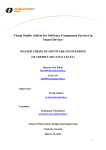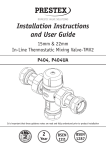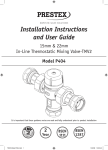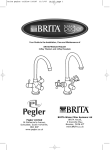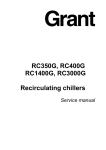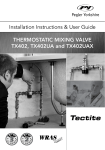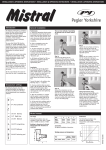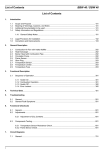Download Installation Instructions and User Guide
Transcript
Installation Instructions and User Guide Installation Instructions 15mm & 22MM In-Line Thermostatic Mixing Valve-TMV2 and User Guide 15mm & 22mm In-Line Thermostatic Mixing Valve-TMV3 Model P404 P402, P402UA It is important that these guidance notes are read and fully understood prior to product installation 2 Year BS 7942 NHS D08 IMPORTANT INTRODUCTION NOTES The valves covered by these instructions have been tested and certified as being in compliance with BS 7942:2000 and NHS Estates Model Engineering Specification D 08. Valves operating outside the requirements of these standards are not covered by the TMV3 Scheme and are not guaranteed to operate as Type 3 valves. The installer should be aware of his duty of care and responsibility in ensuring that compliance with regulations is maintained. The valve is not guaranteed to function correctly to the TMV3 specification unless it is installed and used in accordance with these instructions. Regular servicing is essential to ensure continued safe operation of this thermostatic mixing valve. The recommended service interval must be based on the valve response to the in-service cold water failure test results (see page 6) The installer should be aware of his duty of care and responsibility in ensuring that comp with regulations is maintained. The valve is not guaranteed to function correctly to the T specification unless it is installed and used in accordance with these instructions. Regular servicing is essential to ensure continued safe operation of this thermostatic mix valve. The recommended service interval must be based on the valve response to the incold water failure test results (see page 6) Installation This Pegler Yorkshire Model P402 in-line must thermostatic valve, available in 15mm an Separate isolation valves be mixing installed sizes, is intended to be fitted into applications where the reliable control of hot water on the hot and cold water inlet temperature is necessary to prevent scalding. In thesupplies. event of cold To water supply failure, th product willproper shut off the hot water supply. of the thermostatic ensure performance mixing valve, the isolating valves should Water regulations preferably be full bore and always be fully The Pegler Yorkshireoperation. Model P402 mixing valve must be installed in accordance with the open during regulations of the local water company and the Water Supply (Water Fittings) Regulation The mixing valve is supplied with filter Approvals elements but it is advisable to additionally install Y-strainers on the hot and cold water This product is certified under the BuildCert TMV3 scheme and has been independently t supplies. isolating valves the recognisedThe test laboratory WRc-NSF and is aand Waterstrainers Regulations Advisory Scheme (W approved product and listed in as the Water and Materials Directory. should be installed closeFittings as practicable to the location of the mixing valve and should Installation always be in an accessible location. Separate isolation valves must be installed on the hot and cold water inlet supplies. To en proper performance of the thermostatic mixing valve, the isolating valves should preferab Before installation, the hotoperation. and cold water full bore and always be fully open during The mixingsystems valve is supplied with be filterthoroughly elements but it is advisable supply must flushedto additionally install Y-strainers on the hot and cold water supplies. The isolating valves and strainers should to remove any dirt/debris that may have installed as close as practicable to the location of the mixing valve and should always be accumulated. accessible location. Failure to do so may adversely affect the performance of the mixing valve. Before installation, the hot and cold water supply systems must be thoroughly flushed to any dirt/debris that may have accumulated. Failure to do so may adversely affect the performance of the mixing valve. CONDITIONS OF NORMAL USE CONDITIONS OF NORMAL USE Table 1 Table 1 This Prestex Model P402 in-line thermostatic mixing valve, available in 15mm and 22mm sizes, is intended to be fitted into applications where the reliable control of hot water temperature is necessary to prevent scalding. In the event of cold water supply failure, the product will shut off the hot water supply. Water Regulations The Prestex Model P402 mixing valve must be installed in accordance with the regulations of the local water company and the Water Supply (Water Fittings) Regulations 1999. Approvals This product is certified under the BuildCert TMV3 scheme and has been independently tested by the recognised test laboratory WRc-NSF and is a Water Regulations Advisory Scheme (WRAS) approved product and listed in the Water Fittings and Materials Directory. Operating Range Maximum static pressure - bar Hot & cold flow pressure - bar Hot supply temperature - °C Cold supply temperature - °C High Pressure 10 1.0 to 5 52 to 65 5 to 20 Low Pressure 10 0.2 to 1 52 to 65 5 to 20 Minimum hot inlet to mixed outlet temperature differential = 10oC Note: Valves operating outside these conditions can not be guaranteed by the Scheme to operate as Type 3 valves. The highest flow rates will be achieved under balanced pressure conditions, but the pressure at the valve inlets must be within a ratio of 5:1 under flow conditions and the size and layout of pipework and fittings must take this into account. FITTING Assembly Procedure Before installation, the system operating conditions of inlet pressures, hot water temperature and hot and cold water flow rates should be determined and confirmed to be within the expected conditions of normal use. • Unpack the main valve assembly, remove the three plastic protection caps and check that the bores are free of debris and the end sealing faces are clean. Valves must operate in either a high pressure setting or a low pressure setting. Valves are not capable of operation with, for instance hot water supply in one pressure range and cold water supply in the other pressure range. In these conditions it is necessary to either boost one pressure or reduce the other so that both supplies are within a common pressure range. Correct location of the mixing valve is important to ensure that it is accessible for commissioning and servicing. • The valve body is clearly marked with ‘C’ for Cold and a blue indicator and ‘H’ for Hot and a red indicator. The valve must be correctly connected to the respective supplies • The use of sealing compounds must be avoided since they may intrude into the water supply and impair the valve performance. The Prestex Model P402 thermostatic mixing valve is supplied with the tail pieces, inlet filter screen and main body gasket seals separately located in the packing box. Each tail piece comprises: a housing with union nut and an internally fitted, WRAS approved non return value. • Unpack the two tailpieces and confirm they are complete with union nuts and compression nuts and olives. • Locate the sealing gaskets, insert them into the union nuts against the faces of the tailpieces and screw the union nuts onto the valve until a tight seal has been made. • Remove the compression nuts and olives from the tailpieces. Locate the inlet filter screens and insert them into the bore of the tailpieces up to the shoulder. • Assemble the valve to the pipework and ensure the hot and cold water pipes have full penetration into the tailpiece. • Tighten the compression nuts ensuring that the end of the pipe remains in contact with the filter element. Exploded tailpiece Exploded viewview of tailof pipe assembly assembly The Prestex Model P402UA mixing valve is The Pegler Model Yorkshire P402UA mixing valve is optionally provided with an optionally provided with assemblies in lieu of the tailpiece arrangement shownangled above. This allows the connections of water supplies be parallel to thearrangement mixed water outlet for ease of piping layou lieu oftothe tailpiece shown above. valve assemblies incorporate non-return valves, filters, isolation valves and tes This allows the connections of the hot and cold water supplies to be parallel to the mixed water outlet for ease of piping layouts. The The assemblies comprise an integral full bore ball valve and in-line strainer in angled valve isassemblies incorporate non-return When this arrangement used, the requirements for isolation valves and Y-st mentioned are regarded fulfilled. valves and test points. valves, filters,asisolation Exploded view of angled valve assembly The assemblies comprise an integral full bore ball valve and in-line strainer in an angled housing. When this arrangement is used, the requirements for isolation valves and Y-strainers previously mentioned are regarded as fulfilled. Exploded view of angled valve assembly PRESSURE TAKE-OFF POINT PLUG SEAL HEADWORK SEAL FILTER MESH UNION NUT UNION SEAL ISOLATION VALVE HANDLE ISOLATION VALVE APPLICATION The Prestex Model P402 thermostatic mixing valve has been independently tested by WRc-NSF against the requirements of BS 7942:2000 and NHS D08 and certified as complying with the requirements of the TMV3 Scheme and is suitable for use in the designations shown in the table below. Valves approved for designation for use ‘HP’ only:- If a water supply is fed by gravity then the supply pressure should be verified to ensure the conditions of use are appropriate for the valve. The range of available temperature adjustment is 35°C to 48°C BUT the mixed water temperature at the terminal fitting must never exceed the temperature value for the particular application (i.e. the maximum mixed water temperature may be 2°C above the recommended maximum set outlet temperatures). Note: 46°C is the maximum recommended mixed water temperature from the bath tap. The maximum temperature takes account of the allowable temperature tolerances inherent in thermostatic mixing valves and temperature losses in metal baths 46°C is not a safe bathing temperature for adults or children. The British Burns Association recommends 37°C to 37.5°C as a comfortable bathing temperature for children. In premises covered by the Care Standards Act 2000, the maximum mixed water outlet temperature is 43°C. COMMISSIONING The valve must be commissioned under normal site system conditions and after establishing supply conditions with the hot and cold water supplies open, leave the system running to allow temperatures and pressures to stabilise and be checked. Prior to commencing commissioning, the following checks should be carried out. • The designation of the thermostatic mixing valve matches the application. The supply pressures and temperatures are Table 2 – Required maximum set outlet temperatures at•commissioning. within the operating range of the valve. Application Designation Maximum Set Mixed • Isolating valves and strainers are provided. Water Temperature • The supply temperatures are within the Bidet HP-B 38°C range permitted for the valve and by LP-B guidance information on the prevention of Shower HP-S 41°C legionella etc. LP-S Table 2 - Required maximum set outlet temperatures at commissioning. Washbasin Bath* Bath* (assisted) *22mm *22mm only only HP-W LP-W HP-T44 LP-T44 HP-T46 LP-T46 41°C 44°C 46°C If all these conditions are met, proceed to set the temperature as described below. The Prestex thermostatic mixing valve is supplied factory set at 43°C but the valve may be simply adjusted after installation. When the valve has been installed with the correct conditions of use it is advised that th subjected to exercise prior to the commissioning at the application temperature. Operat from full cold to full hot at least three times. 1. Record the temperature of the hot The mixed water temperature at the With the the valve at the full cold bringwater the valve to the correct application tempera position and cold supplies. terminal fitting must never exceed turning the spanner clockwise. the valve this temperature, the valv 2.IfRecord theovershoots temperature of the mixedreturn maximum temperature setting for the cold condition, and reset it to the correct temperature +0-2°C. Do not set a valve on a provide water at the operation. largest draw-off flow rate. particular application. Note,temperature It is not as this will not consistent 3. Record the temperature of the mixed possible to install one thermostatic mixing the valve is set to the for the application carry out 5 cold w required watertemperature flow at a smaller draw-off flow valve to supply two differingWhen applications isolation tests to further exercise the valve. rate, which shall be measured. unless the temperature of the higher setting 4. Isolate the cold water supply to the is limited to that of the lower application. Commissioning Test sequence of the mixing monitor the mixed After adjust the temperature mixedvalve waterand in accordance with the valve applicatio out water temperature recording the • Remove the plastic protective cap on top of the carry ( see Table 2) and the following sequence: 1. Record the of the hot and cold water supplies. temperature maximum temperature achieved and the the valve with an allen key. 2. Record the temperature of the mixed water at the largest draw-off flow final stabilised temperature. 3. Record the temperature of the mixed water flow at a smaller draw-off f shall 5. Record the equipment, thermometer etc. • using a close fitting rate, which be measured. used for thetomeasurements. spanner, reduce the thecold water 4. Isolate supply the mixing valve and monitor the mixed the maximum temperature achieved and t Note: Therecording final stabilised temperature should mixed outlet water temperature temperature. temperature byfinal stabilised not exceed the values in Table 3 5. Record the equipment, thermometer etc. used for the measurements. turning clockwise. Note: The final stabilised temperature should not exceed the values in Table3 Table 3 - Maximum mixed water • increase the mixed temperatures Table 3 Maximum mixed water temperatures water outlet temperature by Application Mixed water temperature °C turning Bidet 40 counterclockwise. Shower 43 Washbasin 43 Bath (44°C fill) 46 When the valve has been installed with the Bath (46°C fill) 48 correct conditions of use it is advised that the valve is subjected to exercise prior to the In Service Testing In Service Testing commissioning at the application temperature. Operate the valve from full cold to full hot at The purpose of in-service testing is to regularly monitor and record the performance of The purpose of in-service testing is to regularly least three times. thermostatic mixing valve. Deterioration in performance can indicate the need for servic and record the performance of the work on the valve and/or monitor water supplies. thermostatic mixing valve. Deterioration in With the valve at the full cold position out the test sequence detailed above the same or equivalent equipment use performance canusing indicate the need for service bring the valve to the correct Carry application commissioning the valve. work on the valve and/or water supplies. temperature by turning the spanner clockwise. If the valve overshoots this temperature, Carry out the test sequence detailed above return the valve to the full cold condition, and using the same or equivalent equipment used reset it to the correct temperature +0-2°C. Do for commissioning the valve. not set a valve on a lowered temperature as this will not provide consistent operation. If the mixed water temperature has changed significantly from the previous test results When the valve is set to the required (e.g.>1K), record the change and before temperature for the application carry out 5 re-adjusting the mixed water temperature carry cold water isolation tests to further exercise out the following checks; the valve. • All in-line or integral strainers are clean • Any in-line or integral non-return valves or Commissioning Test sequence other anti-backsiphonage devices are in After adjusting the temperature of the mixed good working order. water in accordance with the valve application • Any isolation valves are fully open. (see Table 2) carry out the following sequence: With an acceptable mixed water temperature complete the test sequence detailed above. If the final mixed water temperature is greater than the values in Table 3 and/ or the maximum temperature exceeds the corresponding value from the previous test results by more then about 2K the need for service work is indicated. In-service tests should be carried out with a frequency which identifies a need for service work before an unsafe water temperature can result. Frequency of in-service testing 6 to 8 weeks after commissioning carry out the test sequence detailed above 12 to 15 weeks after commissioning carry out the test sequence detailed above. Depending on the results obtained, the following course of actions must be followed: • If no significant changes (e.g.<1 K) in mixed water temperature are recorded between commissioning and testing at 6 to 8 weeks, or between commissioning and testing at 12 to 15 weeks, the next in- service test can be deferred to 24 to 28 weeks after commissioning. • If small changes (e.g.1 to 2 K) in mixed water temperature are recorded in only one of these periods, necessitating adjustment of the mixed water temperature, then the next in-service test can be deferred to 24 to 28 weeks after commissioning. • If small changes (e.g.1 to 2 K) in mixed water temperature are recorded in both of these periods, necessitating adjustment of the mixed water temperature, then the next in-service test should be carried out at 18 to 21 weeks after commissioning. • If significant changes (e.g. >2 K) in mixed water temperature are recorded in both of these periods, necessitating service work, then the next in-service test should be carried out at 18 to 21 weeks after commissioning. The general principle to be observed after the first 2 or 3 in-service test is that the intervals of future tests should be set to those which previous tests have shown can be achieved with no more than a small change in mixed water temperature. Note: If there is a residual flow during the commissioning or bi-annual verification (cold water supply isolation test) then this is acceptable providing the temperature of the water seeping from the valve is no more than 2°C above the designated maximum mixed water outlet temperature setting of the valve. Temperature readings should be taken at the normal flow rate after allowing the system to stabilise. The sensing part of the thermometer probe must be fully submerged in the water that is to be tested. Any TMV that has been adjusted or serviced must be re-commissioned and re-tested in accordance with the manufacturer’s instructions. In the absence of any other instruction or guidance, it is recommended that In-Service Tests are carried out once every 6 months as a minimum. TMV Cleaning and Servicing Instructions Most domestic water supplies contain calcium which will separate out when the water is heated in a system. The degree and speed of scaling may vary depending on factors such as water flow rates, system design, the hardness of the water and the temperature to which the water is heated. Deposits of scale may over time form in the valve, particularly at the hot inlet. The formation of the scale may adversely affect the performance of the valve which will be detected during the in-service testing. If this occurs it will be necessary to remove the valve for de-scaling and servicing. TO SERVICE THE VALVE: SPARES 30.0° • Isolate the hot and cold supply. • Remove the valve to a clean working area. In order to ensure that the Prestex Model P402 • Remove the protective cap. thermostatic mixing valve continues to provide • UnscrewInstructions the headwork of the valve. satisfactory service, only GENUINE Pegler spare ng and Servicing • Carefully remove the element and valve parts must be used. ic water supplies contain will separate out when the water is assembly andcalcium put towhich one side. ystem. The degree and scaling may varyguide depending • Remove thespeed main ofspring and flow and on factors such as tes, system design, the the water and the temperature to which the carefully puthardness to one of side. 2 ed. • Inspect the components for contamination cale may over time form in the valve, particularly at the hot inlet. The formation or damage. may adversely affect the performance of the valve which will be detected during or replace asnecessary necessaryto remove the valve for de-scaling1 e testing. • If Clean this occurs it will be • Remove the two o rings . • Clean the valve body and headwork using a te the hot and cold supply. propriety de-scaler 3 ove the valve to a clean rinse working • Thoroughly thearea. body and headwork in ove the protective cap. clean water. rew the headwork of the valve. • Carefully fit new o rings from the service kit 4 5 fully remove the element and valve assembly and put to one side. taking care to ensure they are not ove the main spring and flow guide and carefully put to one side. damagedforand are correctly 7 ect the components contamination or located. damage. • Lubricate the o rings with the lubricant n or replace as necessary 4 provided. ove the two o rings n the valve using propriety de-scaler • body Re-fitand theheadwork flow guide anda spring lubricating oughly rinse theflow bodyguide and headwork in clean water. the around the greatest fully fit new o rings from thethe service kit taking care to ensure they are not diameter with lubricant provided aged and• are correctly the located. Lubricate shuttle valve with the 6 cate the o rings with the lubricant provided. lubricant provided t the flow guide and spring lubricating the flow guide around the greatest Re-fit the shuttle eter with• the lubricant providedvalve and element cate the assembly. shuttle valve with the lubricant provided • Re-fit ensuring correct t the shuttle valve the and headwork element assembly. t the headwork ensuring correct tightening tightening t the valve • assembly Re-fit the assembled valve and perform the er cleaning the valve, and sequence. replacing the o ring seals, the valve does not function comissioning ectly, it may be necessary to replace the thermal element. • If after cleaning the valve, and replacing the Spare part order Description o ring seals, the valve does not function code w of TMV assembly correctly, it may be necessary to replace the 1 854446 Protective cap thermal element. complete with screw Exploded view of TMV assembly 2 854447 Hexagon key 3 854448 Service kit 4 854449 (15mm) 854450 (22mm) Tailpiece Strainer kit 5 854451 (15mm) 854452 (22mm) Angle valve strainer kit 6 854456 (15mm), 854457 (22mm) Sealing washer 7 854455 (15mm), 817012 (22mm) Wafer Strainer Our brands: UK Sales Free Phone: 0800 156 0010 Free Fax: 0808 156 1011 Email:[email protected] Export Tel: +44 (0) 1302 855 656 Fax: +44 (0) 1302 730 513 Email:[email protected] Technical Help Free Phone: 0800 156 0050 Free Fax: 0808 156 1012 Email:[email protected] Brochure Hotline Free Phone: 0800 156 0020 Free Fax: 0808 156 1011 Email:[email protected] www.pegleryorkshire.co.uk Pegler Yorkshire Group Limited Also available from Pegler Yorkshire: LUXURY TAP SOLUTIONS St. Catherine’s Avenue, Doncaster, South Yorkshire, DN4 8DF, England. Tel: 0844 243 4400 Fax: 0844 243 9870 Registered in England Company No. 00401507 Registered Office: Haigh Park Road, Stourton, Leeds, West Yorkshire, LS10 1RT, England. All brand names and logo styles are registered trademarks. Maintaining a policy of continual product development, Pegler Yorkshire reserves the right to change specifications, design and materials of products listed in this leaflet without prior notice.








